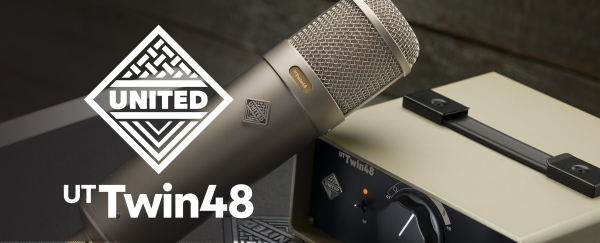Bringing Two Vintage Legends into One: The United Studio Technologies UT Twin48
In the world of high-end studio microphones, few items carry as much mystique (and cost) as the “47” and “48” style tube condensers — classic mics from the late 1940s and 1950s that have defined the sound of countless recordings. But owning one of those originals — in good condition — is both difficult and expensive. United Studio Technologies (UT) has taken a bold step: the UT Twin48 is a new microphone that aims not just to replicate one classic, but to bring both of these revered designs into a single, flexible tool.
This isn’t just a clone; it’s a hybrid (or “twin”) in more ways than one. Here’s what the Twin48 offers, what works well, what to look out for, and whether it might make sense for your studio.
What the Twin48 Does & What’s Inside
Two Modes: 47 & 48
A key feature of the Twin48 is that it provides two historically distinct mic modes in a single body.
-
47 Mode: Offers “47 Cardioid” and "47 Omni". The cardioid mode here is called “True Cardioid”—where the rear diaphragm is decoupled to give a more open, sensitive sound, with more ambience and top-end detail.
-
48 Mode: Offers “48 Cardioid” and "48 Figure-8". The cardioid in this mode is achieved differently ("Active Cardioid," where the rear diaphragm is polarized along with the backplate) yielding a more intimate, warmer sound, lower in sensitivity.
So, depending on what you're recording (vocals, acoustic guitar, strings, horns, etc.) you get options: the more airy, open character of the 47 side, or the richer, thicker texture of the 48.
Components & Build Quality
United didn’t cut corners. Some of the standout design/internals:
-
Capsule: UT K48 custom capsule — dual diaphragm, single backplate, 34 mm brass, 6-micron Mylar, gold-sputtered. Designed to be very close to the originals in feel and sound. United Studio Technologies+1
-
Tube: Uses a “new old stock” EF86 pentode tube — the same type (or descendant) as used in the vintage originals. That gives it a harmonic profile more in line with what made vintage 47/48s so desirable. United Studio Technologies+1
-
Transformer: The UT-BV8 transformer is a custom one, US-made, wound to original specifications (Braunbuch spec), high-nickel alloy laminations, copper Faraday shielding to reduce interference. United Studio Technologies+1
-
Power Supply: External, discrete rails, high-quality regulation, good filtering of RF/EMI, etc. For a tube mic, the PSU matters a lot. UT seems to have put effort into ensuring noise is kept low and that the mic is stable. United Studio Technologies+1
Physical & Practical Specs
-
Frequency range: 20 Hz – 20 kHz. United Studio Technologies+1
-
Max SPL: approx 137 dB @ 0.5% THD. United Studio Technologies+1
-
Self noise: about 11 dB (A-weighted). United Studio Technologies+1
-
Output transformer, external PSU, cable included, shockmount; it comes with a briefcase style case. United Studio Technologies+1
What the Review Says: Sound, Performance, & Character
The MusicTech review describes the UT Twin48 as sounding fabulous, especially when recording acoustic guitar. The mic captures “superb results” for that application. MusicTech
Some engineers note how you achieve strong results without needing to grab other mics or spend time finding just the right vintage unit. That flexibility (switching between the 47- and 48-modes) allows you to adapt depending on performance, room, vocalist, etc., without swapping gear. United Studio Technologies+2MusicTech+2
Also, people have pointed out that the Twin48 tends to smooth out harshness or sibilance compared to cheaper vintage-style copies, due to its capsule design and electronics. It’s not overly bright; there’s a richness and creaminess that many find pleasing. United Studio Technologies+2msonic Baltic+2
However, some notes of caution: for very forward, modern vocal production (think “in your face” pop/hip-hop vocals), the richer character may need some EQ or supplementary mics to get maximum clarity or edge. Also, tube mics in general are larger, heavier, require external PSU, and have some maintenance/operational trade-offs (warm-up time, tube life etc.). But this is true of any mic in this class.
What is it Great For?
Here are scenarios where the Twin48 seems particularly well suited:
-
Acoustic guitar: The airy top end of the 47 mode, or the richer warmth of 48 mode, both allow you to capture beautiful and musical tone. The review highlights that as one of its best use cases. MusicTech
-
Strings and orchestral instruments: Because of its smooth high-end and low distortion at high SPL, plus pattern versatility, it's good for detail without harshness.
-
Vocals (especially when you want vintage warmth): For singer/songwriter, jazz vocals, or anything where a more “classic” or “luxury” mic sound is desired.
-
Room enables airy recording: In a good room, the sensitivity and detail allow you to get ambient cues (especially with the omni or figure-8 modes) that enhance the sense of space.
Where might it Be Less Ideal?
It’s not all perfect, and some situations may see less benefit or require compromise:
-
Very modern vocals needing precision: If you want something razor-sharp, ultra-bright, super tight (e.g. for certain pop, rap, voice-overs), you might find the Twin48 a little too lush, and may need EQ or pairing with another mic.
-
Budget and cost factor: The unit is not cheap (price is significant, especially when you include the PSU, case, etc.). For someone building a starter studio, this is a premium tool.
-
Physical logistics: Big mic, external PSU, warm-up times and tube maintenance. Also, tube mics generally require more careful cabling, grounding, and noise control.
-
Sensitivity & gain: In very loud environments (or needing very loud sources), might require careful gain staging to avoid overload; similarly in very quiet sources, you may hear noise more if preamps are less than ideal.
Verdict: Who Should Consider the Twin48
If you are serious about having a versatile, high-end tube mic that can deliver both the airy clarity of a 47 and the richer, more intimate voice of a 48, the Twin48 is a rare kind of tool. For studios that already have good preamps, good rooms, and want a “one mic, many voices” machine, it seems like a strong investment.
If you’re more into hard-edged modern styles, or on a tight budget, or need very rugged / portable setups, then you might get more utility out of mics tailored to that niche (possibly spend less or use more than one cheaper mic to cover desired tonal palette).
Final Thoughts
The UT Twin48 does something increasingly rare: it bridges two classic microphone worlds with fidelity and engineering rigour. It doesn’t just mimic; it gives you intentional choices—choice of character, of pattern, of clarity vs warmth—all baked into one mic. The build, components, and design appear top-tier, and user reviews, especially from MusicTech, praise the results.
If I were building or upgrading a studio and could stretch the budget, I’d likely pick this up as a centerpiece mic. It could reduce the need to own multiple classic clones if it indeed covers both those spaces well enough.


